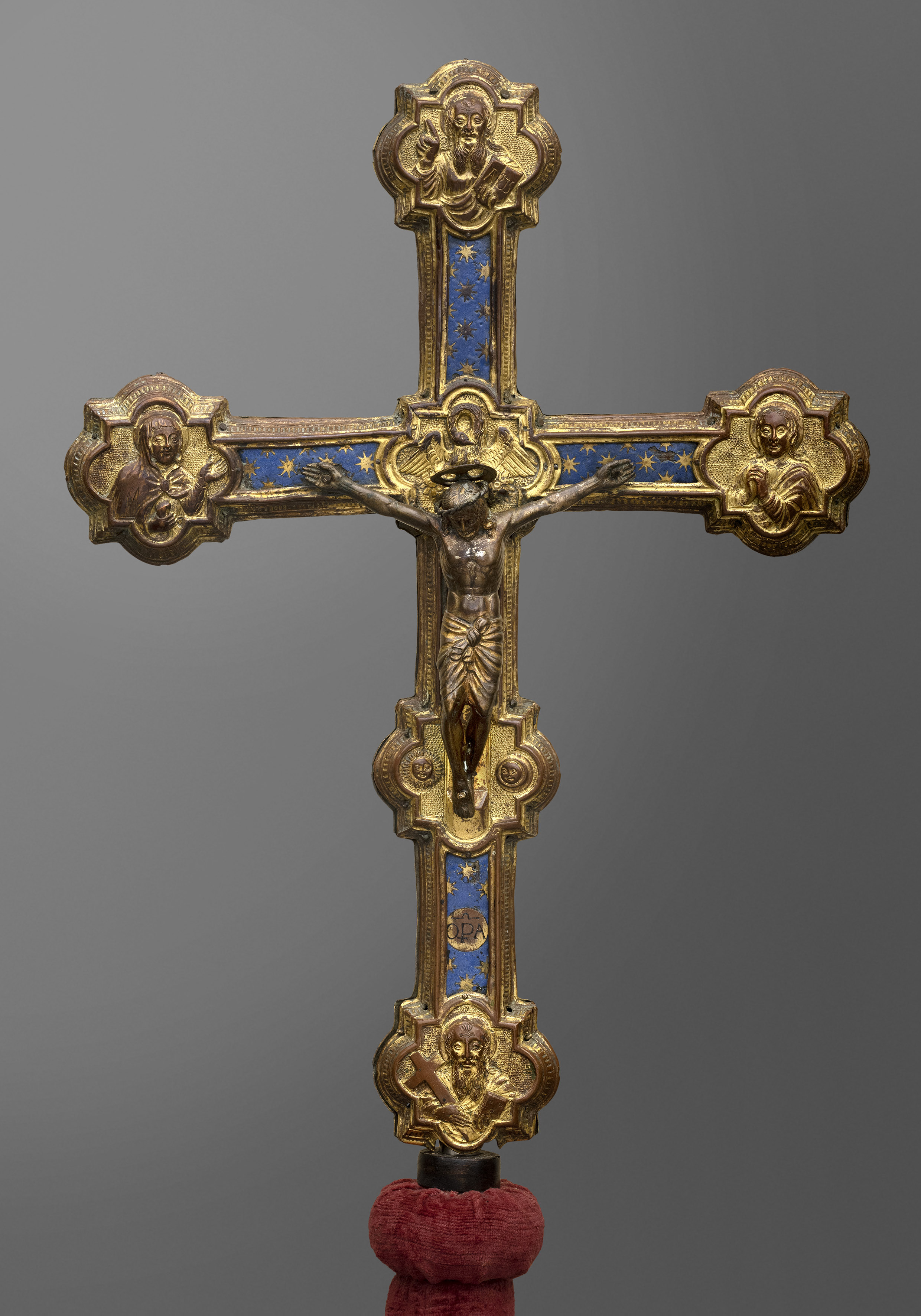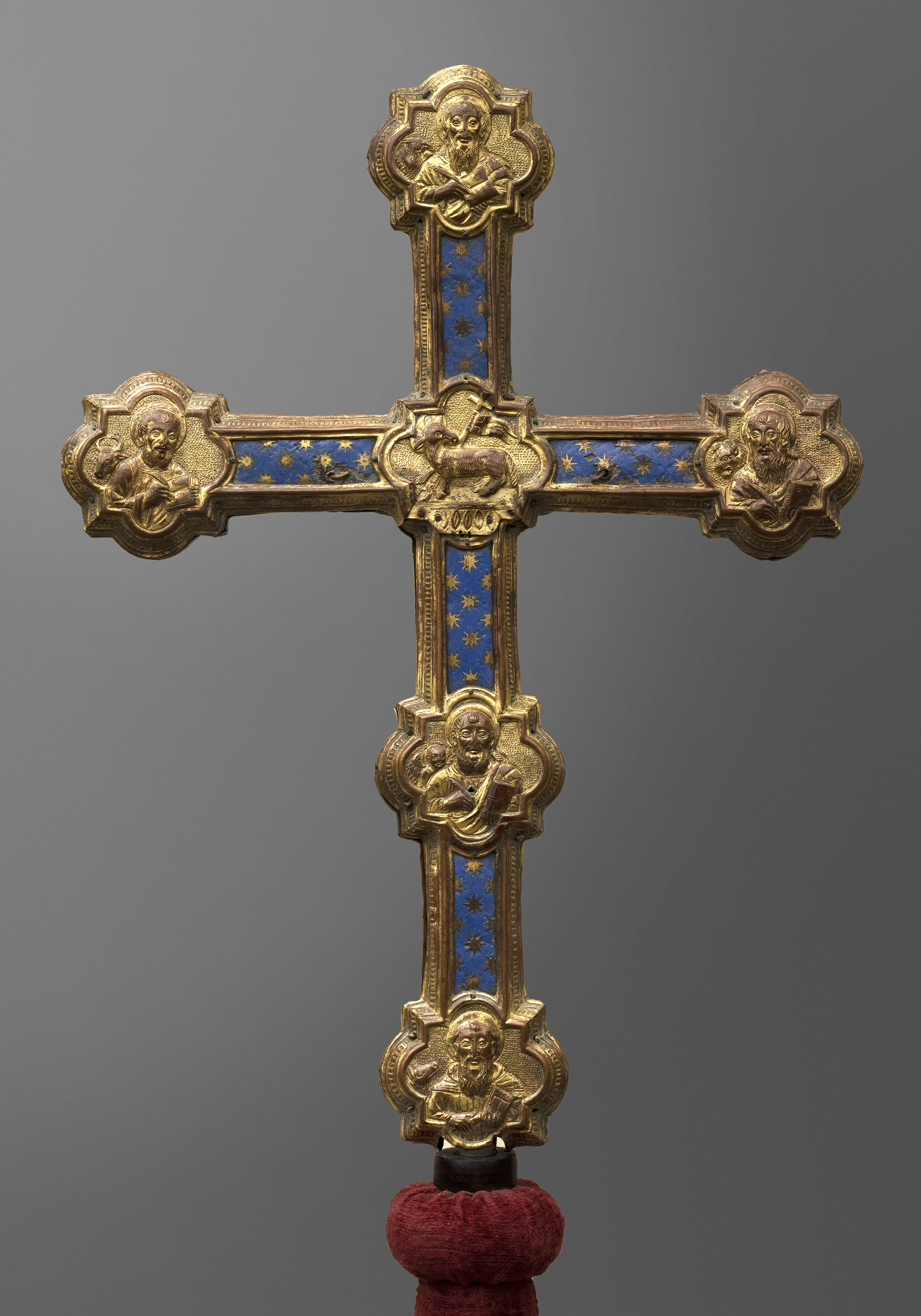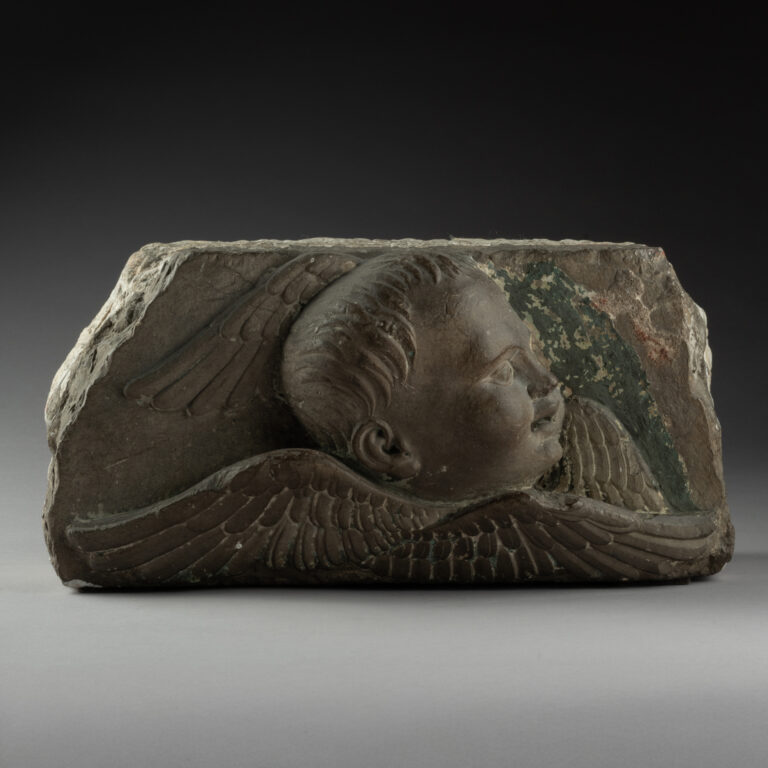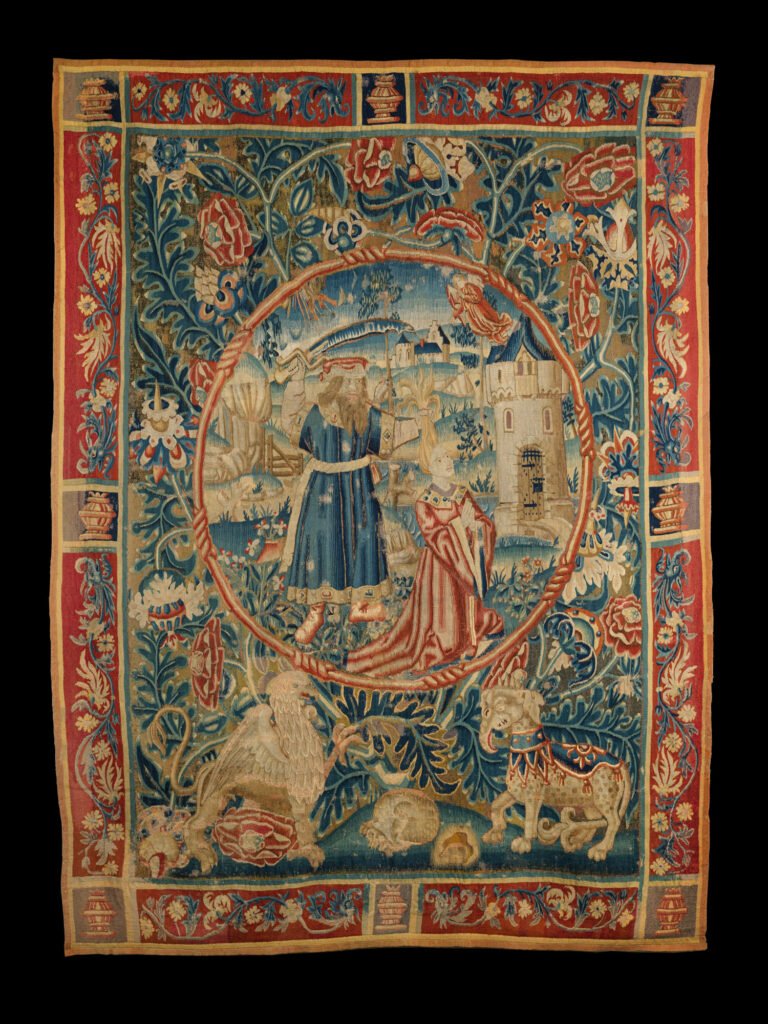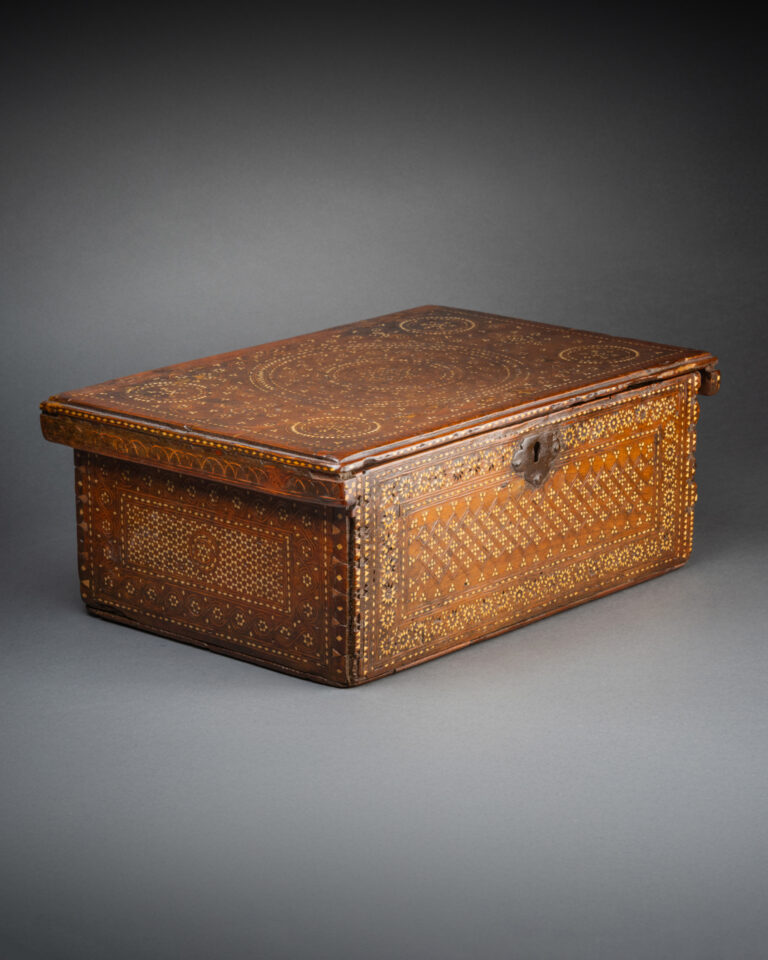Provenance:
– Probably, Santa Maria del Fiore cathedral, Florence.
– Private collection in Umbria, Italy (since 1980)
Exhibitions:
– A. Del Priori, in « Rinascimento Segreto », curated by Vittorio Sgarbi, pp. 188-191, no. 10

Composed of two gilded copper parts welded around a wooden core, the cross is entirely adorned with stars against a blue enamel background. The front features a round figure of Christ, accompanied by reliefs of God the Father blessing, the Virgin Mary, Saint John, and Saint Philip the Apostle at the ends of the cross. Behind Christ, a relief depicts the symbolic image of a pelican sacrificing itself to feed its young with its entrails. At Christ’s feet, the sun and moon symbolize the eclipse that accompanied His agony.
The back of the cross depicts the four evangelists, Saint Anthony the Abbot and the Agnus Dei, a symbol of the Arte della Lana, one of the seven major guilds of Florence, which held patronage over the Florentine cathedral.
The iconographic program invites the faithful to respect the teachings of the Gospels and, through symbols of sacrifice (the pelican and the Lamb), to follow the path of Redemption leading to Dante’s Paradise, particularly the eighth heaven of the “fixed stars,” where the light of triumphant souls reflects the light Christ transmits to them1.
Various elements tie this cross to the Santa Maria del Fiore Cathedral. Notably, the OPA mark on the starry background holds particular importance, representing the Opera del Duomo, or Opera di Santa Maria del Fiore (literally “work of the cathedral”). This secular institution, founded in 1296 by the Republic of Florence, was tasked with overseeing the cathedral’s construction and preserving its sacred legacy. Furthermore, the presence of the Agnus Dei, symbol of the Arte della Lana, further emphasizes the connection between this significant cross and the Florentine cathedral.
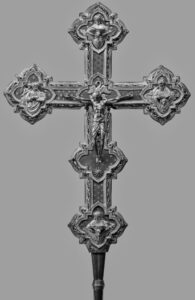
A comparable cross with a starry background can be found at the Museo dell’Opera del Duomo in Florence. Initially attributed to Luca della Robbia, this rare example of goldsmithing has since been recognized as a commissioned work by Antonio Salvi and Michelangelo di Viviano (father of Baccio Bandinelli) in 1514.
Another connection to the Opera of the Florentine Cathedral is the depiction of Saint Philip and Saint Anthony the Abbot. The relics of both saints are preserved at Santa Maria del Fiore, for which two precious reliquaries were commissioned and are now exhibited in the cathedral museum: the first was started in 1398 by an anonymous goldsmith and completed in 1425 by Antonio del Vagliente; the second was created in 1514 by Antonio di Salvi.
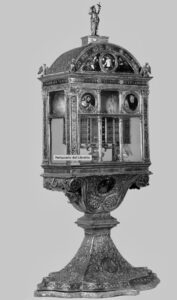
Characterized by archaic features typical of Renaissance goldsmithery, this processional Cross resonates with the style of mid-Quattrocento Florentine masters such as Mino da Fiesole, Rossellino, and Gregorio di Lorenzo. The morphology of Christ shows the influence of Donatello, along with the new language of Benedetto da Maiano and Sangallo, evident in the athletic rendering of the body with pronounced abdominals and robust pectorals. The frontality of Christ, with His head leaning forward rather than resting to the side, recalls Antonio del Pollaiolo’s Crucifix in San Lorenzo in Florence. The long, tied perizoma at the front appears to be a blend of 15th-century models and contemporary works.
These stylistic and iconographic considerations, particularly the presence of the OPA mark, prompted art historian Francesco Traversi to attribute this rare cross to Paolo di Giovanni Sogliani2, the goldsmith of the Duomo Opera, and to include it in the exhibition catalog3 .
This cross closely aligns stylistically with Sogliani’s works from the early 16th century. Notably, the figures of the Evangelists resemble the faces of the two angels on the Reliquiario del Libretto, (housed within the “Temple” that contains the reliquary, crafted by Sogliani in 1500–1501)4. However, the presence of Saint Anthony the Abbot suggests a date closer to 1514, when the saint’s reliquary was completed by Antonio di Salvi.
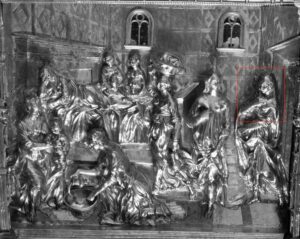
Bibliography:
Il Museo dell’Opera del Duomo a Firenze, vol. II, edited by L. Becherucci and G. Brunetti, Milan, 1970.
A. Del Priori, in Rinascimento segreto, edited by Vittorio Sgarbi, pp. 188-191, no. 10.
D. Liscia Bemporad, Storie d’argento. L’altare e la croce di San Giovanni, la croce e l’altare d’argento del Tesoro di San Giovanni, edited by T. Verdon, Modena, 2012, pp. 11-34.
D. Liscia Bemporad, “L’oreficeria a Firenze nella prima metà del Cinquecento: Paolo di Giovanni Sogliani,” in Storia degli studi dell’arte medievale e moderna nel centenario della nascita di Mario Salmi, Proceedings of the International Conference (Arezzo – Firenze 1989), Florence, 1992, vol. II, pp. 787-800.
Argenti Fiorentini dal XV al XIX secolo. Tipologie e marchi, edited by D. Liscia Bemporad, Florence, 1992.
« Ecco le schiere/ del triunfo di Cristo e tutu ‘l frutto/ricolto del girar di queste sfere!/ (…) vid’i’ sopra migliaia di lucerne/ un sol che tutte quante l’accendea,/ come fa ‘l nostro le viste superne » (Dante Alighieri, Media, Paradiso, XXIII, 19-30) ↩︎
Although there is no document to confirm it, it is believed that Sogliani, after leaving the workshop of his master Pollaiolo, followed him to Rome and, upon his death in 1498, returned to Florence. There, he immediately received several prestigious commissions, including the reliquary for the Libretto for the Baptistery (Florence, Museo dell’Opera del Duomo) and the reliquary of San Giovanni Gualberto for the Abbey of Vallombrosa, both completed in 1500. ↩︎
A. Del Priori, in Rinascimento Segreto, a cura di Vittorio Sgarbi, pp. 188-191, n. 10 ↩︎
The Reliquary of the Libretto preserved in the Museo dell’Opera del Duomo in Florence consists of two elements: the Reliquary in its own right and the little “Temple” that contains it. The first, as indicated by the elegant inscription drawn above one of the gold lame in the verse, is a gift from King Charles V of France to his younger brother Louis of Anjou; the second was commissioned to Paolo di Giovanni Sogliani in 1500-1501 by the Art of Calimala in Florence to contain, protect and enhance it, in view of its destination at the Baptistery of San Giovanni. ↩︎
